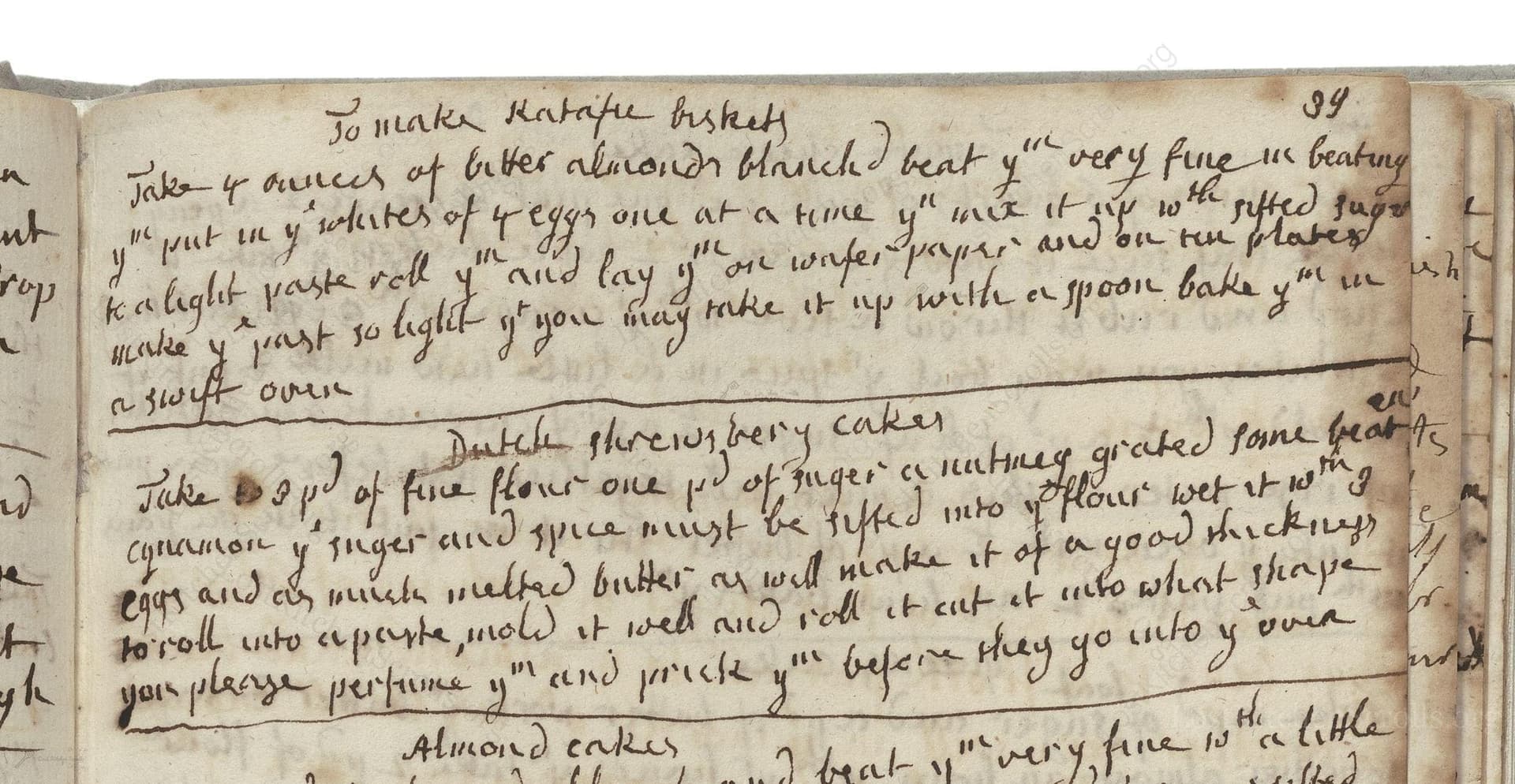To Make Naples Biskets
From the treasured pages of Mrs. Knight's receipt book
Written by Mrs. Knight

To Make Naples Biskets
"Take 4 ounces of almonds blanched beat ym very fine in beating ym one at a time yr mix it wth sifted suger you may lay ym on wafer paper and on tin plates wth which you may take it up with a spoon bake ym in a swift oven"
Note on the Original Text
The recipe is written in the straightforward, conversational style characteristic of manuscript recipes in the 18th century: direct, concise, and dependent on practical kitchen knowledge. Spelling is variable, and words are abbreviated—'ym' stands for 'them,' 'wth' for 'with,' and 'suger' for 'sugar.' Quantities are minimal, and instructions such as 'bake ym in a swift oven' expect the reader to rely on experience to determine heat and timing—standard practice before widespread literacy and mass-produced cookbooks. Measurements are given in ounces rather than grams, but the proportions remain simple and easy to adapt.

Title
Mrs. Knight's receipt book (1740)
You can also click the book image above to peruse the original tome
Writer
Mrs. Knight
Era
1740
Publisher
Unknown
Background
Step into the refined kitchens of 18th-century England with Mrs. Knight’s culinary collection, where time-honored recipes, hearty roasts, and elegant pastries await the enterprising cook.
Kindly made available by
Folger Shakespeare Library
This recipe is drawn from an 18th-century English manuscript, attributed to Mrs. Knight, circa 1740. Naples biscuits, or 'biskets,' were delicate almond-based treats popular in England and across Europe, often served with tea or as a refined nibble at gatherings. The recipe reflects a moment when British cooks were enthusiastically borrowing and adapting sweets from continental Europe—here, an Italian influence is clear in the use of almonds and wafer paper, echoing the continental love for crisp, nutty biscuits.

Back in the 1740s, cooks would blanch almonds using a pot over an open hearth, then grind them using a mortar and pestle—a labor-intensive but aromatic process. To mix in the sugar and achieve a smooth batter, a wooden spoon or spatula sufficed. The batter was then portioned onto wafer paper, which could be purchased from the apothecary or made at home, and placed on tin baking plates. The biscuits were baked in a 'swift' (hot) brick oven, with careful judgment required to avoid scorching the delicate sweets.
Prep Time
10 mins
Cook Time
15 mins
Servings
12
We've done our best to adapt this historical recipe for modern kitchens, but some details may still need refinement. We warmly welcome feedback from fellow cooks and culinary historians — your insights support the entire community!
Ingredients
- 4 ounces whole raw almonds (blanched; modern substitute: ground almonds/almond meal if needed)
- 4 ounces caster sugar (sifted)
- Wafer paper or baking parchment (for lining trays)
Instructions
- Begin by blanching 4 ounces of raw almonds—simply submerge them in boiling water for a minite, then slip off their skins.
- Grind the almonds very finely, ideally using a food processor to achieve a paste-like texture.
- Next, gradually add 4 ounces of sifted caster sugar to the ground almonds, mixing continuously to form a cohesive batter.
- Because the original calls for "beating them one at a time," add the sugar slowly and mix until thoroughly combined after each addition.
- Line a baking tray with edible wafer paper or baking parchment.
- Spoon small mounds of the almond mixture onto the paper, shapping as desired.
- Place the tray in a preheated oven at around 350°F (180°C)—a hot, swift oven as recommended in the text.
- Bake for 10–15 minutes or until lightly golden.
- Allow to cool before serving.
Estimated Calories
60 per serving
Cooking Estimates
You will need about 10 minutes to prep the almonds and other ingredients, and 15 minutes to bake the cookies. Each cookie has around 60 calories, and the recipe makes about 12 cookies.
As noted above, we have made our best effort to translate and adapt this historical recipe for modern kitchens, taking into account ingredients nowadays, cooking techniques, measurements, and so on. However, historical recipes often contain assumptions that require interpretation.
We'd love for anyone to help improve these adaptations. Community contributions are highly welcome. If you have suggestions, corrections, or cooking tips based on your experience with this recipe, please share them below.
Join the Discussion
Rate This Recipe
Dietary Preference
Main Ingredients
Culinary Technique
Occasions

Den Bockfisch In Einer Fleisch Suppen Zu Kochen
This recipe hails from a German manuscript cookbook compiled in 1696, a time whe...

Die Grieß Nudlen Zumachen
This recipe comes from a rather mysterious manuscript cookbook, penned anonymous...

Ein Boudain
This recipe comes from an anonymous German-language manuscript cookbook from 169...

Ein Gesaltzen Citroni
This recipe, dating from 1696, comes from an extensive anonymous German cookbook...
Browse our complete collection of time-honored recipes



